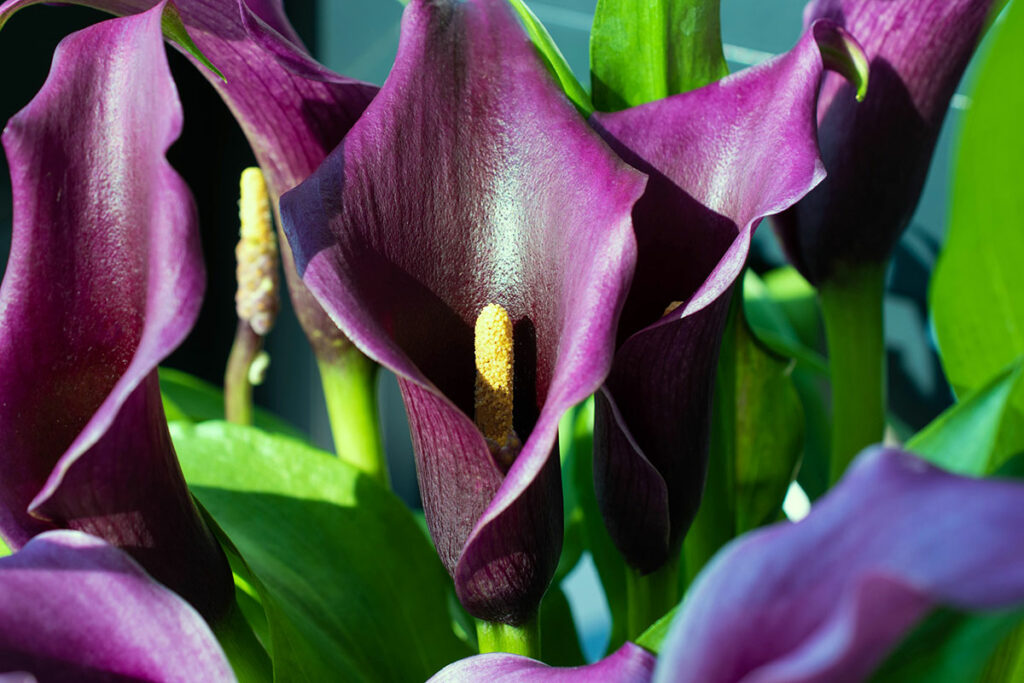
Despite its name, the ornamental plant known as the Calla Lily isn’t a true lily — it’s a member of the Araceae family, which includes a vast number of flowering plant genera and species characterized by clusters of tiny flowers surrounded by trumpet-shaped bracts. Often mistaken for flowers, the bracts are what give Calla Lilies their striking looks and come in a range of colors including white, yellow, pink, orange, red, and purple.
Native to the marshes of South Africa, Calla Lilies are a favorite of gardeners and florists because of their showy appearance and exquisite aroma.
Their elegant form and presence sometimes lead novice gardeners to assume that Calla Lilies are fussy plants with complex cultivation requirements, but fortunately, this is not the case. Here’s what you need to know to successfully cultivate Calla Lilies.
Cultivating Calla Lilies
Although Calla Lilies can be grown from seed, it can take three years for the seedlings to reach the maturity necessary to produce those trademark showy blooms, and most people would rather not wait that long.
The vast majority of Calla Lilies growing in home gardens were propagated by dividing the rhizomes of an existing plant. In order for the rhizomes to grow, they must have roots and eyes attached.
Most home gardeners purchase the rhizomes from yard and garden retailers, while some get the rhizomes from other home gardeners who are dividing their plants. Most home gardeners plant Calla Lilies directly into the ground in the spring, although they also grow well in containers and make striking specimen plants on patios, decks, and balconies.
Sun and Temperature Requirements
Calla Lilies perform best in home gardens in USDA hardiness zones 8 through 11. Although they prefer full sun, Calla Lilies can be placed in partial shade in climates where midday temperatures are hot. Because they’re native to a geographical location with a subtropical climate, Calla Lilies don’t respond well to cold and shouldn’t be planted before the final frost of the season, and those living where winter temperatures routinely get below 20 degrees Fahrenheit should bring their container-grown Calla Lilies indoors for the winter, and rhizomes planted directly in the ground should be dug up, removed, and stored in peat moss in a cool, dry area until the next spring.
Best Watering Practices
As marsh plants, Calla Lilies love water and make excellent options for adding dramatic flair around koi ponds, fountains, and other backyard water features. However, Calla Lilies also require excellent drainage in order to thrive because perpetually soggy roots may lead to a variety of fungal conditions. Pathogens that develop in poorly drained soil include root rot, crown rot, and pythium rot. All three result in weakened plants with stunted growth and yellowing leaves.
Because Calla Lilies require a period of dormancy so that their roots can regenerate for the next year, so gardeners should cease providing them with added water after the blooms have faded and the foliage begins to fade.

Soil and Fertilizer Needs
Calla Lilies like their soil slightly on the acidic side, so gardeners should aim for between 5.6 to 6.5 pH. This can easily be accomplished in all but the most alkaline soils by adding organic amendments when readying the soil for planting. Fertilizing them during the growing season with a mild, balanced fertilizer every two weeks helps keep Calla Lilies healthy.
Toxicity to Pets
Home gardeners need to be mindful that Calla Lilies contain calcium oxalate crystals, a substance that is toxic to dogs and cats. Curious domestic pets who chew or bite on Calla Lily foliage or flowers may experience a variety of symptoms, including vomiting, dizziness, swollen lips and tongues, drooling, foaming at the mouth, and difficulty swallowing and breathing. For safety’s sake, households that include pets should be mindful of the potential danger that Calla Lilies pose and plant them in areas inaccessible to them.
Can Calla Lilies Be Grown Indoors?
Calla Lilies also make an excellent houseplant. Cultivation requirements when grown indoors in containers are similar to when the plants are sited in outdoor gardens — they require moist, acidic soil with good drainage, bright light, and a period of dormancy after they’ve passed their bloom time. They put on their best performance when situated near a window that faces east or west, but they do need protection from the hot midday sun because it can burn their leaves.






